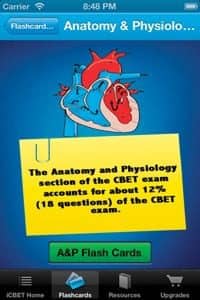Becoming a Certified Biomedical Equipment Technician (CBET) is a big undertaking. The 3-hour exam contains questions on topics including anatomy and physiology, fundamentals of electricity, health care technology function, health care technology management problem solving, and information technology. Study materials can contain hundreds and hundreds of practice questions. In every way, studying for and taking the test is a marathon, not a sprint. Luckily, there are plenty of tips and tools that can act as guideposts along the way.
 Dustin K. TelfordDustin. K. Telford, CBET, CRES, CLES, is an imaging service engineer at Intermountain Healthcare, Salt Lake City. He knows a thing or two about certification. In addition to holding all three certifications offered by the International Certification Commission for Clinical Engineering and Biomedical Technology (ICC), he also serves as a member of the US BMET Board of Examiners. He helps write the questions for all the exams. “We don’t try to preclude people, but we do try to challenge them,” he says. Twice a year, the board reviews the test, which comprises 165 multiple-choice questions, to make sure questions are both up-to-date and useful. Recently, the exam gained a sixth section, which covers health care information technology.
Dustin K. TelfordDustin. K. Telford, CBET, CRES, CLES, is an imaging service engineer at Intermountain Healthcare, Salt Lake City. He knows a thing or two about certification. In addition to holding all three certifications offered by the International Certification Commission for Clinical Engineering and Biomedical Technology (ICC), he also serves as a member of the US BMET Board of Examiners. He helps write the questions for all the exams. “We don’t try to preclude people, but we do try to challenge them,” he says. Twice a year, the board reviews the test, which comprises 165 multiple-choice questions, to make sure questions are both up-to-date and useful. Recently, the exam gained a sixth section, which covers health care information technology.
But not everyone wants to become certified, according to Telford. Common reservations range from cost (up to $375, plus the cost of any study materials) to a lack of support from a current employer. While everyone must make their own cost-benefit analysis, nobody should question his or her chances of passing the exam if they are dedicated to sticking with a study plan. Although the test could never be classified as easy, a measured approach to studying should lead to a passing rate of 70%. In addition to 24×7‘s bimonthly ICC Prep column, in which an expert shares an explanation of a concept or piece of equipment from the CBET exam, we’ve asked a few experts about the tips and tools they’ve found to be most successful over the years.
Study Strategies
Once a person registers for the exam, Telford suggests flipping to the back of the examination handbook. There, registrants can see a detailed outline of the exam. It is broken down into six main categories, and each category has subcategories. By gauging one’s familiarity with each section, Telford says people can craft a more strategic study plan. Although this step might seem obvious, he adds that he still sees people skip this step or simply glance through it, with mixed results.
Test taking is an individual activity, but studying often works best in groups. “I think it’s important for people to find a study group or some other people to help support them,” Telford says. “Maybe it’s even a spouse who reads off questions. That support is really important.” David Scott, CBET, biomedical technician at Children’s Hospital Colorado, Aurora, helped start one of the most successful group study courses available. Since it began in 2004, the Colorado Association of Biomedical Equipment Technicians (CABMET) study group has helped more than 1,000 people become certified: One out of seven people with CBET certification studied with CABMET.
 David ScottIn recent years, more than half of newly certified CBETs signed up for the study group. “We started the study group in 2004 just to study locally in the Denver area. We did really well. Almost all of us passed. Other people in Colorado asked about it, so we ran another one. Then we had people in more remote areas start saying, ‘We want to do it, but we don’t live in Denver.'” The study group, which convenes via the Internet, is now available to anyone in the world.
David ScottIn recent years, more than half of newly certified CBETs signed up for the study group. “We started the study group in 2004 just to study locally in the Denver area. We did really well. Almost all of us passed. Other people in Colorado asked about it, so we ran another one. Then we had people in more remote areas start saying, ‘We want to do it, but we don’t live in Denver.'” The study group, which convenes via the Internet, is now available to anyone in the world.
CABMET’s study group’s recipe for success is this: One part accountability, one part experience, andone part practice. CABMET has teamed up with other BMET associations to make pricing affordable to anyone in the country—members from other associations can take the course as a group and pay CABMET rates.
Studying as a group has two benefits. First, it allows people to pool their strengths: Person A might know more about subject Y than subject Z, and Person B might know more about Z than Y. They can help one another through the various topics.
Second, joining a group helps create accountability. Finding time to study can be difficult, and it’s easier to skip a week or two of studying if nobody is counting on you. This holds true whether study groups sign up with CABMET or not. The experience of CABMET’s instructors also goes a long way. Scott, along with nearly a dozen others, has compiled key study points, presentations, and practice tests for much of the past decade.
Scott adds that those studying for a test should focus on the thought processes that got them to the answer rather than on the answer itself. He says that when some people take practice tests, they skip right to the answer section instead of working though the problem. By internalizing why an answer is right, people will be better prepared when, on test day, the question is posed a different way.
Each week, the study group focuses on one of the six exam sections. This method, as opposed to studying a little of everything each week, allows members to really drill down into the concepts. After a lecture by an expert in the area, the group can ask questions. Telford suggests that people look for others in their department who are an expert in a subject area that could use a little more study attention. Spend some time with them, or even shadow them for a few hours, if possible.
Study Aids
 Manuel JimenezSome people who sign up for the exam will be many years removed from school. Study habits and test-taking skills might be rusty. Getting back into the groove might take a week or two, but for the most part, it’s like riding a bike. Study skills haven’t really changed—only the subject matter is different. Flashcards are an example of a tool that can easily be adapted into a CBET study aid. Manuel Jimenez, BEET, CBET, senior biomedical technician at Mount Sinai Medical Center in New York, capitalized on this idea. When studying for his own CBET exam, he noticed he had to buy a number of different study books: He wanted a simpler solution. “The idea behind the app was to get these study materials in one convenient place,” he says. He created an iOS app, called iCBET, that contains hundreds of flash cards and links to useful sites, including the latest handbook from AAMI.
Manuel JimenezSome people who sign up for the exam will be many years removed from school. Study habits and test-taking skills might be rusty. Getting back into the groove might take a week or two, but for the most part, it’s like riding a bike. Study skills haven’t really changed—only the subject matter is different. Flashcards are an example of a tool that can easily be adapted into a CBET study aid. Manuel Jimenez, BEET, CBET, senior biomedical technician at Mount Sinai Medical Center in New York, capitalized on this idea. When studying for his own CBET exam, he noticed he had to buy a number of different study books: He wanted a simpler solution. “The idea behind the app was to get these study materials in one convenient place,” he says. He created an iOS app, called iCBET, that contains hundreds of flash cards and links to useful sites, including the latest handbook from AAMI.
Because it works on phones and tablets, people generally will have access to it wherever they go. When waiting in line, on a trip, or at lunch, people can put those extra minutes to good use. More than 300 people have downloaded iCBET. The flexibility that the app allows reflects Jimenez’s tip that people need to find their own path. Even if someone signs up for a study group, they need to find time in their own life to study.
 The iCBET app is useful for study on the run.Another popular study resource is the study book from the Association for the Advancement of Medical Instrumentation (AAMI), the group that administers the exam. The BMET Study Guide: Preparing for Certification and Sharpening Your Skills comes with 151 new sample questions. The study guide comes on a CD and allows users to choose between instant feedback and a no-feedback mode that mimics the actual exam.
The iCBET app is useful for study on the run.Another popular study resource is the study book from the Association for the Advancement of Medical Instrumentation (AAMI), the group that administers the exam. The BMET Study Guide: Preparing for Certification and Sharpening Your Skills comes with 151 new sample questions. The study guide comes on a CD and allows users to choose between instant feedback and a no-feedback mode that mimics the actual exam.
Studying for and taking the CBET test is a sizable task, but by breaking down the test into manageable sections and approaching them methodically, people can work their way toward a passing grade. By leveraging the skills and knowledge of others, with a group such as CABMET or even a small group of colleagues at a coffee shop once a week, people can position themselves for success. 24×7 Focus On May 2013
Kurt Woock is the associate editor of 24×7. Contact him at [email protected].





